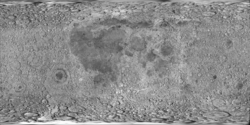| Stevinus Cráter lunar | ||
|---|---|---|
 Imagen de la misión Lunar Orbiter 5 | ||
| Coordenadas | 32°29′S 54°08′E / -32.49, 54.14 | |
| Diámetro | 75 km | |
| Profundidad | 3.0 km | |
| Colongitud | 306° al amanecer | |
| Epónimo | Simon Stevin | |
|
Localización sobre el mapa lunar | ||


Stevinus es un cráter de impacto localizado en la parte sureste de la Luna. Al sureste aparece el gran cráter Furnerius, y justo al noreste se halla Snellius y el Vallis Snellius. Al oeste-noroeste se encuentra Reichenbach. Al oeste-noroeste de Stevinus aparece el pequeño cráter Stevinus A, un elemento que posee un pequeño sistema de marcas radiales y un exhibe un alto albedo.[1]
 |
Stevinus posee una alta pared interna y un pico central en el punto medio del suelo interior. Las paredes interiores están hundidas, de manera que se inclinan primero abruptamente hacia el centro del cráter y luego de manera más gradual. Presenta varias crestas pequeñas sobre la plataforma.[2]
Debido a su sistema de marcas radiales, Stevinus se clasifica como parte del Período Copernicano.[3]
Lleva el nombre de Simon Stevin, un matemático e ingeniero belga del siglo XVI.[1]
Cráteres satélite
Por convención estos elementos son identificados en los mapas lunares poniendo la letra en el lado del punto medio del cráter que está más cerca de Stevinus.[4]
 |
|
Imágenes
 |
 |
 |
Véase también
Referencias
- ↑ a b Autostar Suite Astronomer Edition. CD-ROM. Meade, April 2006.
- ↑ Rükl, Antonín (1990). Atlas of the Moon. Kalmbach Books. ISBN 978-0-913135-17-4.
- ↑ The geologic history of the Moon, 1987, Wilhelms, Don E.; with sections by McCauley, John F.; Trask, Newell J. USGS Professional Paper: 1348. Plate 11: Copernican System (online)
- ↑ Bussey, B.; Spudis, P. (2004). The Clementine Atlas of the Moon. New York: Cambridge University Press. ISBN 978-0-521-81528-4.
- (WGPSN), IAU Working Group for Planetary System Nomenclature (13 de febrero de 2013). «Gazetteer of Planetary Nomenclature. 1:1 Million-Scale Maps of the Moon» (en inglés). UAI / USGS. Consultado el 6 de abril de 2016.
- Andersson, L. E.; Whitaker, E. A., (1982). NASA Catalogue of Lunar Nomenclature (en inglés). NASA RP-1097.
- Blue, Jennifer (25 de julio de 2007). «Gazetteer of Planetary Nomenclature» (en inglés). USGS. Consultado el 2 de enero de 2012.
- Bussey, B.; Spudis, P. (2004). The Clementine Atlas of the Moon (en inglés). Nueva York: Cambridge University Press. ISBN 0-521-81528-2.
- Cocks, Elijah E.; Cocks, Josiah C. (1995). Who's Who on the Moon: A Biographical Dictionary of Lunar Nomenclature (en inglés). Tudor Publishers. ISBN 0-936389-27-3.
- McDowell, Jonathan (15 de julio de 200). «Lunar Nomenclature» (en inglés). Jonathan's Space Report. Consultado el 2 de enero de 2012.
- Menzel, D. H.; Minnaert, M.; Levin, B.; Dollfus, A.; Bell, B. (1971). «Report on Lunar Nomenclature by The Working Group of Commission 17 of the IAU». Space Science Reviews (en inglés) 12: 136.
- Moore, Patrick (2001). On the Moon (en inglés). Sterling Publishing Co. ISBN 0-304-35469-4.
- Price, Fred W. (1988). The Moon Observer's Handbook (en inglés). Cambridge University Press. ISBN 0521335000.
- Rükl, Antonín (1990). Atlas of the Moon (en inglés). Kalmbach Books. ISBN 0-913135-17-8.
- Webb, Rev. T. W. (1962). Celestial Objects for Common Telescopes, 6ª edición revisada (en inglés). Dover. ISBN 0-486-20917-2.
- Whitaker, Ewen A. (2003). Mapping and Naming the Moon (en inglés). Cambridge University Press. 978-0-521-54414-6.
- Wlasuk, Peter T. (2000). Observing the Moon (en inglés). Springer. ISBN 1-85233-193-3.
- «Lunar Impact Crater Database» (en inglés). Lunar and Planetary Institute (USRA). Consultado el 12 de septiembre de 2017.
Enlaces externos
- Referencia UAI del CRÁTER
- LPI Digital Lunar Orbiter Photographic Atlas of the Moon
- Mapa LROC
- The-moon.wikispaces.com: Stevinus
 Wikimedia Commons alberga una categoría multimedia sobre Stevinus.
Wikimedia Commons alberga una categoría multimedia sobre Stevinus.

